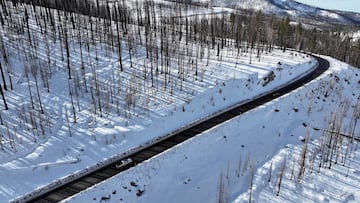This is how wind chill is calculated: Below freezing temperatures expected in the Midwest this winter
In addition to snow and ice, windchill will make going outside significantly colder in many parts of the United States.


In case you hadn’t heard, or already felt it, this winter is and will continue to be colder than usual in many parts of the United States, with the Midwest set to be among the regions most affected.
In December, a report from the National Energy Assistance Directors Association (NEADA) revealed average spending on home heating this winter would rise to $941 from $866 last year, an increase of 8.7%, partly due to the increasing cost of maintaining the electricity grid but also due to lower temperatures.
Meanwhile, according to the National Weather Service, a huge winter storm extending 1,300 miles across the country is expected to affect up to 62 million people between Saturday and Monday.
❄️January 4-6 Winter Storm❄️
— National Weather Service (@NWS) January 3, 2025
Disruptive Winter Storm This Weekend
There is high confidence for significant wintry weather beginning this weekend. Impacts will start in the Central Plains by late Saturday, then across the Ohio Valley on Sunday where severe travel disruptions are… https://t.co/e2Sj6N73XG
The weather agency has warned of a 60% to 90% chance of at least eight inches of snow on Sunday from central Kansas to Ohio, which could be the heaviest snowfall in over a decade for some areas. Kansas and Missouri in particular could potentially experience up to 14 inches of snow.
Winter Storm Warnings are in effect in at least 12 states, including Kentucky, Indiana, Maryland, West Virginia, Kansas, Montana, Illinois, Iowa, Missouri, Michigan, Pennsylvania, Virginia, and Nebraska.
These areas, and undoubtedly others, will be affected by windchill, which makes it feel much colder than the thermometer will measure.
How is windchill defined?
According to the National Oceanic and Atmospheric Administration (NOAA), windchill measures the “effect of the cold wind on people and animals,” looking at “the rate of heat loss from exposed skin caused by wind and cold. As the wind increases, it removes heat from the body, driving down skin temperature and eventually the internal body temperature”. This video from Idaho News provides a helpful description as well.
How is windchill calculated?
The example provided by the agency shows that if a thermometer is reading 0°F (-18°C), and wind in the area “is blowing at 15 mph (13 kt / 24 km/h),” it will feel like it is -19°F (-28°C) outside. Measuring the windchill is critical to keeping people and animals safe during periods of extreme cold. To help out, NOAA provides a chart that allows viewers to figure out the windchill in their area by identifying the intersection between wind (mph) and temperature (°F).
At -19°F, the risk of frostbite is extreme and could occur in just a few minutes.
Tips on how you can stay warm
The threat of cold temperatures cannot be overstated. Given that major storms can lead to power outages, it is advised that residents of towns and cities know where to go or how to contact the authorities if their electricity fails. Getting to a warming center or alerting the authorities so you can be transported to one can be the difference between life and death when temperatures drop and winter weather follows.
Other tips may seem obvious but are worth highlighting given their importance.
Aside from staying inside with the heater on, people can take a few steps to stay warm as temperatures fall. The first is to layer up, which creates a larger buffer between your body and the cold and is extremely important if you are heading outside. People tend to lose a lot of heat from their heads, so throwing a hat on can help your body retain heat.
Additionally, eating warm foods and drinking warm beverages throughout the day can help keep your body temperature up.
NOAA also advises those who live alone to have someone, be it a family member or neighbor, check in on them during major storms.
Related stories
Get your game on! Whether you’re into NFL touchdowns, NBA buzzer-beaters, world-class soccer goals, or MLB home runs, our app has it all.
Dive into live coverage, expert insights, breaking news, exclusive videos, and more – plus, stay updated on the latest in current affairs and entertainment. Download now for all-access coverage, right at your fingertips – anytime, anywhere.


Complete your personal details to comment